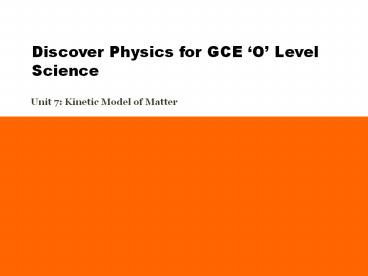Project Overview PowerPoint PPT Presentation
Title: Project Overview
1
Discover Physics for GCE O Level Science
Unit 7 Kinetic Model of Matter
2
7.1 The States of Matter
- Learning Outcomes
- In this section, youll be able to
- Compare the properties of solids, liquids and
gases - Describe the molecular structure of solids,
liquids and gases - Describe Brownian motion
- Describe the effects of temperature on Brownian
motion
3
7.1 The States of Matter
- Matter exists as a solid, liquid and gas.
- These are referred to as the three states of
matter. - Similarly, substances can exist in three states.
- The properties of a substance differ between each
states.
4
7.1 The States of Matter
Table 7.1 Properties of solids, liquids and gases.
5
7.1 The States of Matter
- The Kinetic Model of Matter
- All matters are made up of tiny particles called
atoms or molecules (group of atoms joined
together) - These particles are in constant motion.
- The continuous motion of these particles is known
as kinetic model of matter. - This theory can explain the difference in
properties between each states.
6
7.1 The States of Matter
Table 7.2 Properties of solids, liquids and gases
7
7.1 The States of Matter
- The kinetic model of matter
- The relative strengths of the intermolecular
forces between the particles differ between the
different states of matter. - The relative distances between the particles also
differ between the different states of matter.
8
7.1 The States of Matter
- Evidence of molecular motion (Experiment 7.1)
9
7.1 The States of Matter
- Evidence of molecular motion
- From Experiment 7.1 in the textbook, we see that
smoke particles in air move in a random and
irregular way. - This is referred to as Brownian motion.
- Brownian motion occurs only in fluids where the
particles have the ability to flow or move
freely. - Fluids include liquids and gases.
10
7.1 The States of Matter
- Effects of temperature on molecular motion
- At higher temperatures, the motion of smoke
particles will become more vigorous and agitated. - This is because the air molecules are bombarding
the smoke particles more vigorously and
frequently. - The air molecules have greater speeds at higher
temperatures. - The thermal energy is converted to kinetic energy
of air molecules, causing it to move faster.
11
7.1 The States of Matter
- Key Ideas
- 1. All substances exist in three states of
matter solid, liquid and gas. - The kinetic model of matter describes matter as
being made up of tiny particles (atoms or
molecules) in continuous motion. - Brownian motion is the random or irregular motion
of smoke particles in air or pollen grains in
water. When temperature increases, the smoke
particles or pollen grains are observed to move
faster and more vigorously. - Brownian motion is caused by the bombardment of
air molecules of smoke particles in air or water
molecules on pollen grains in water.
12
7.1 The States of Matter
- Test Yourself
- 1. Using the kinetic model of matter, explain why
the density of a gas is much lower than that of a
solid. - Answer
- In solids, the particles (or atoms) are closely
packed. - In gases, the particles are far apart.
- Since density is the mass per unit volume, then
solids must have a much higher density since
there are many more particles packed closely
together per unit volume compared to gases.
13
7.1 The States of Matter
- Test Yourself
- 2. What is Brownian motion in air? What causes
it? - Answer
- Brownian motion refers to the random, irregular
and jerky motion of smoke particles in air. - The smoke particles are continually bombarded
unevenly on different sides by - air molecules. This results in the irregular
movement of the smoke particles.
14
7.1 The States of Matter
- Test Yourself
- 3. (a) As temperature is increased, how would
the movement of smoke particles in Brownian
motion change? - 3. (b) What would you expect to see if the
smoke particles are much larger? - Answer
- 3. (a) As temperature increased, the motion of
the smoke particles become more vigorous and
agitated. - 3. (b) Larger smoke particles tend to have less
irregular and less jerky motion.
15
(No Transcript)

